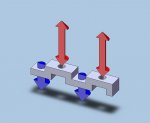Still talk...no proof.
Nothing here tells me spacers are unsafe...according to you they should be breaking left and right and they in fact are not.
You've been asked repeatedly to support your statements, and those requests have been ignored. From that I infer that all you're really interested in is trolling.
----------------------------------------------------------------
Simply changing the material to a ferrous alloy would virtually eliminate the fatigue issue, but that isn't what is being sold to the uninformed/unsuspecting public. Were there room to design the adapter (spacer) more like those used on dually pick-ups then there would not be a problem.
Be clear that I don't have a problem with adapter (spacers) used for what they were originally intended for, to increase scrub radius on comp buggies as a traction aid. In that type of situation the risks are accepted, and really aren't all that great due to the low(er) speeds and limited operation time.
When someone take such a product and misapplies it then he or she is putting everyone around them at risk too. Should it fail and cause he or she to drive off a cliff then that was their choice. When driving off the cliff if they also take out Joe Average and his family, Now I have a problem with the misapplication. When this happens often enough the legislature will get involved, and then the whole situation will become really screwed up!
The thing about fatigue that I don't get the sense that most layman understand is that it is not an instant failure. "It works, don't worry about it" is the mentality. Just because it works right now does not mean that it will continue to work for the next 2-50 years. There are those who proudly state "I've been running them for X years without a problem!" Great, they don't appear to understand that this sort of failure is not something that happens instantly. It happens over time. That they've been running them for X years just means that they have X fewer years of life left in those parts. In short, the fuse has been lit, but no one knows exactly when the bomb will go off.

